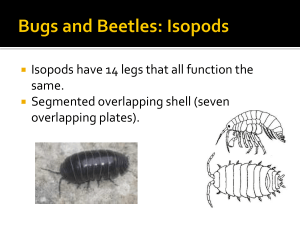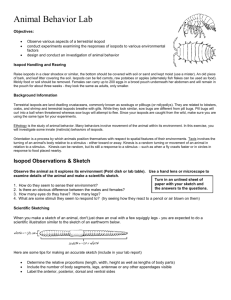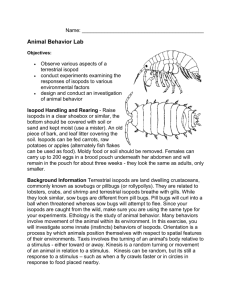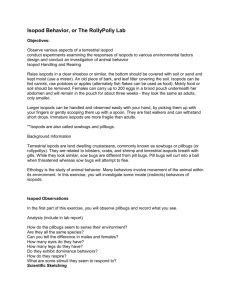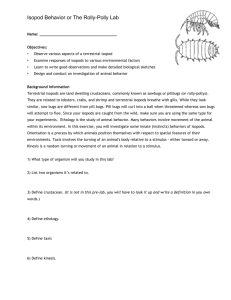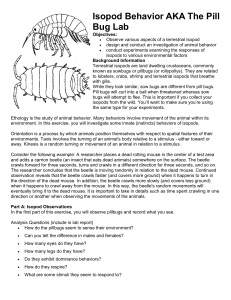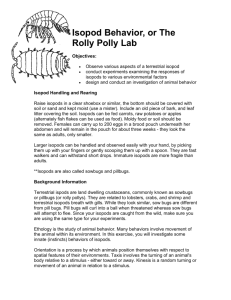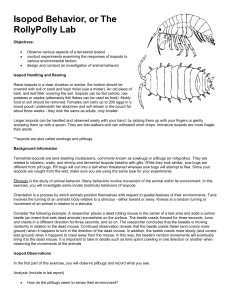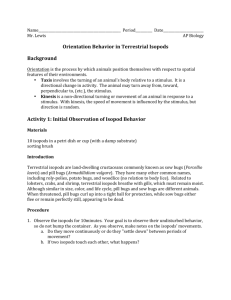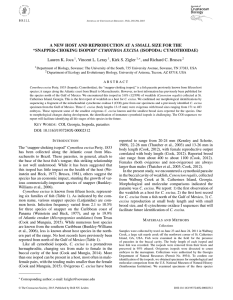Animal Behavior Lab - Lucinda Supernavage
advertisement
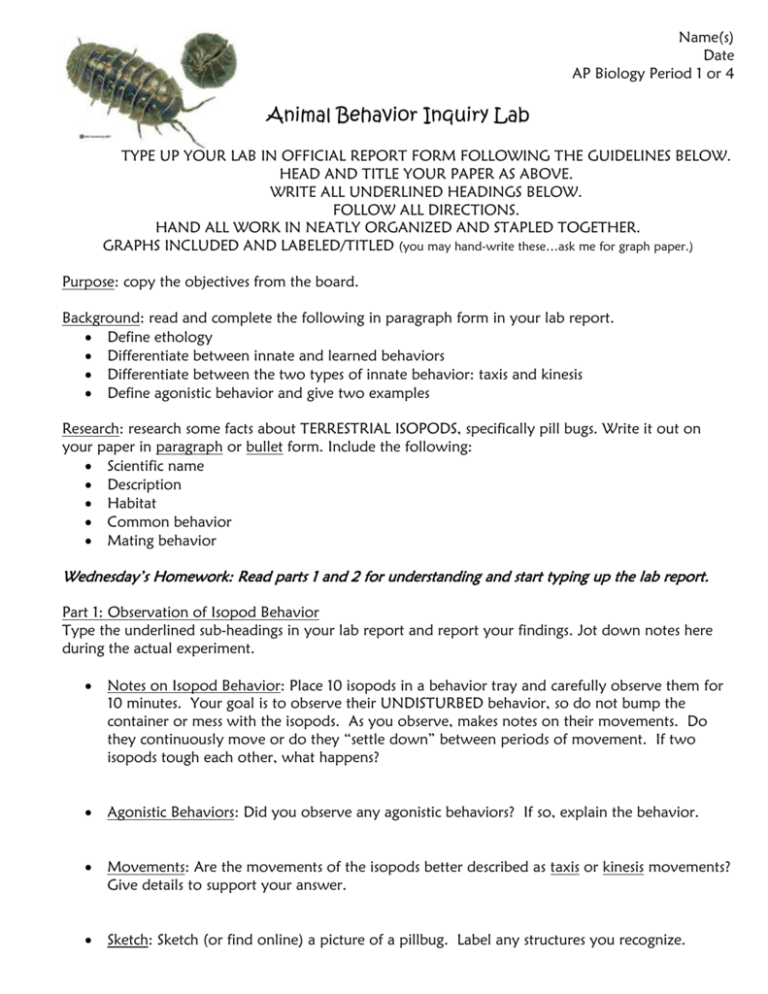
Name(s) Date AP Biology Period 1 or 4 Animal Behavior Inquiry Lab TYPE UP YOUR LAB IN OFFICIAL REPORT FORM FOLLOWING THE GUIDELINES BELOW. HEAD AND TITLE YOUR PAPER AS ABOVE. WRITE ALL UNDERLINED HEADINGS BELOW. FOLLOW ALL DIRECTIONS. HAND ALL WORK IN NEATLY ORGANIZED AND STAPLED TOGETHER. GRAPHS INCLUDED AND LABELED/TITLED (you may hand-write these…ask me for graph paper.) Purpose: copy the objectives from the board. Background: read and complete the following in paragraph form in your lab report. Define ethology Differentiate between innate and learned behaviors Differentiate between the two types of innate behavior: taxis and kinesis Define agonistic behavior and give two examples Research: research some facts about TERRESTRIAL ISOPODS, specifically pill bugs. Write it out on your paper in paragraph or bullet form. Include the following: Scientific name Description Habitat Common behavior Mating behavior Wednesday’s Homework: Read parts 1 and 2 for understanding and start typing up the lab report. Part 1: Observation of Isopod Behavior Type the underlined sub-headings in your lab report and report your findings. Jot down notes here during the actual experiment. Notes on Isopod Behavior: Place 10 isopods in a behavior tray and carefully observe them for 10 minutes. Your goal is to observe their UNDISTURBED behavior, so do not bump the container or mess with the isopods. As you observe, makes notes on their movements. Do they continuously move or do they “settle down” between periods of movement. If two isopods tough each other, what happens? Agonistic Behaviors: Did you observe any agonistic behaviors? If so, explain the behavior. Movements: Are the movements of the isopods better described as taxis or kinesis movements? Give details to support your answer. Sketch: Sketch (or find online) a picture of a pillbug. Label any structures you recognize. Part 2: Orientation Behavior of Isopods in Response to Hydrotaxis In this activity, you will observe isopods as they respond to humidity differences in their environment over time. Hypothesis: Materials: 10 isopods in a behavior tray sorting brush dropping pipet marking pen two pieces of filter paper choice chamber water stopwatch/timer (use of cell phone is permitted) Results: You will type up the following data table in your lab report. Fill the one below in during your experiment: 0:00 0:30 1:00 1:30 2:00 2:30 3:00 3:30 4:00 4:30 5:00 5:30 6:00 6:30 7:00 7:30 8:00 8:30 9:00 9:30 10:00 WET ENVIRONMENT Side A DRY ENVIRONMENT Side B 5 5 READ THE WHOLE PROCEDURE FIRST BEFORE COMPLETING THE STEPS SO THAT YOU CAN BE SURE YOU KNOW WHAT YOU ARE DOING. Procedure: 1. Label each side of the behavior tray as either A (wet) or B (dry). 2. Place clean filter paper into each side of the choice chamber. 3. Using the dropping pipet, saturate the filter paper on side A of the chamber. Pour off any excess water; do not let the water run into the other side of the chamber and moisten the paper there. 4. Use the sorting brush to transfer five isopods to each side of the chamber. Put on the lids. 5. Count and record in the table the number of animals on each side of the chamber, every 30 seconds for 10 minutes. Continue to record even if the isopods all move to one side or stop moving. Analysis: Graph the data from your results table for both the wet side and the dry side of the chamber. This graph may best be done as a histogram and may be completed using a graphing program or by hand (INDIVIDUALLY). Title the graph and include both variables. Then answer the questions below in full sentences. 1. Independent Variable: 2. Dependent Variable: 3. Write a hypothesis for this experiment. 4. What serves as a control for this experiment or what needs to be done to establish a control for this experiment? 5. Based on your observations, do isopods orient with respect to moisture in the environment? Explain your answer. 6. If you answered yes to the question above, was the orientation achieved through taxis or kinesis? Support your answer. 7. How might this behavior be advantageous to isopods? Thursday’s Homework: Read through part 3 of the lab and decide what variable you would like to test with your group (NOT humidity since that was done in part 2 already). THERE ARE MANY VARIABLES FROM WHICH TO CHOOSE. YOU AND YOUR LAB GROUP SHOULD DECIDE ON ONE AND CHECK WITH MS. SUPERNAVAGE BEFORE PROCEEDING. PLEASE BE CERTAIN YOU DO NOT INJURE THE ISOPODS! Part 3: Designing an Experiment to Test Isopod Behavior In this activity, you will design and conduct your own experiment investigating isopod behavior. Materials: 10 isopods in a behavior tray sorting brush other materials to be determined (differs between groups) WHAT TO INCLUDE IN YOUR OFFICIAL LAB REPORT: 1. The factor we are testing… 2. Based on your laboratory experience with isopods, write a hypothesis for your experiment. Your hypothesis should include the conditions tested, the expected outcome, and a reason for the expected outcome (If…then…because…). 3. List the materials needed for this experiment. 4. List the procedure to be followed (step-by-step). STOP AND HAVE MS. SUPERNAVAGE CHECK YOUR WORK!!! 5. Describe the data that will be collected and how the results will be displayed. 6. Perform the experiment. 7. Return the isopods to the stock culture. 8. Display your results via tables and graphs. As an individual, you may use a graphing program to complete this. 9. Write out your conclusions concerning the tested hypothesis.
